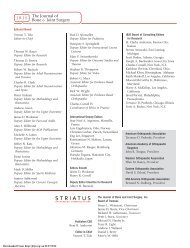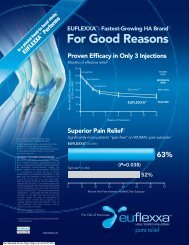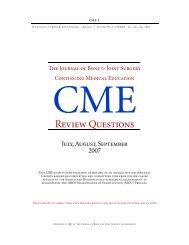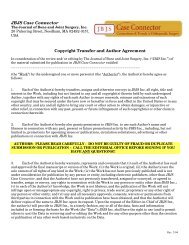Lower-Extremity Rotational Problems in Children - The Journal of ...
Lower-Extremity Rotational Problems in Children - The Journal of ...
Lower-Extremity Rotational Problems in Children - The Journal of ...
You also want an ePaper? Increase the reach of your titles
YUMPU automatically turns print PDFs into web optimized ePapers that Google loves.
@<br />
44 L. T. STAHELI, MARILYN CORBETT, CRAIG WYSS, AND HOWARD KING<br />
ErrorPresent<br />
* Averages are <strong>in</strong> parentheses.<br />
Inter-Exani<strong>in</strong>erIntra-Exani<strong>in</strong>erStandardMeanStandard<br />
MeanL)eviationErrorDeviation<br />
studyPhotographic3.81-4.252.65-3.481.52-2.16<br />
1.11-1.56(3.941(3.081(l.86(<br />
(1.35)Cl<strong>in</strong>ical.<br />
<strong>in</strong>vestigated(6.481(4.911Other<br />
over-all4.9()-8.9()3.33-6.78Not<br />
studiesAshton<br />
1.70(hip)(8.40)Bocmne<br />
et al.6.01-I<br />
TABLE II<br />
RANGES AND AVERAGES* FOR INTER-EXAMINER AND INTRA-EXAMINER<br />
VARIABILITIES IN MEASUREMENT (IN DEGREES) DETERMINED IN THIS ANt) OTHER STUDIES<br />
.4(shoulder. and Aze&0.2-I<br />
.0)forearm. elbow .I I<br />
hip.knee. wrist.<br />
footBooneankle.<br />
al.1.5-4.60.6-1.4(shoulder.<br />
et<br />
elbow.(2.9)(1.0)wrist.<br />
knee.tOot)Ekstrand<br />
hip.<br />
al.'2.5-5.5(hip. et<br />
ankle)(3.7)Low knee.<br />
(elbow. wrist 14.4-7. 7<br />
(5.62)3.3-6.3 (4.6)0.69-3.69<br />
<strong>of</strong> childhood on, the mean angle rema<strong>in</strong>ed approximately<br />
10 degrees and the range <strong>of</strong> normal values was from —¿ 5<br />
to 30 degrees.<br />
Angle <strong>of</strong> the transnialleolar O.V1S(Fig . 2-F): <strong>The</strong> angle<br />
<strong>of</strong> this axis <strong>in</strong>creased and became slightly less variable with<br />
age. <strong>The</strong> mean angles and the normal ranges <strong>of</strong> the trans<br />
malleolar axis were greater than those <strong>of</strong> the thigh-foot<br />
angle. From the middle <strong>of</strong> childhood on. the mean approx<br />
imated 20 degrees and the ranges <strong>of</strong> normal were from zero<br />
to 45 degrees.<br />
Discussion<br />
As shown <strong>in</strong> Table II, the <strong>in</strong>ter-exam<strong>in</strong>er and <strong>in</strong>tra<br />
exam<strong>in</strong>er variabilities, standard deviations, and mean errors<br />
were used to compare the exam<strong>in</strong>er variabilities <strong>in</strong> the cur<br />
rent study with the f<strong>in</strong>d<strong>in</strong>gs <strong>in</strong> other reliability studies'5<br />
<strong>The</strong> f<strong>in</strong>d<strong>in</strong>gs <strong>in</strong> our study compare favorably with the values<br />
reported <strong>in</strong> other studies (Table II). For the <strong>in</strong>tra-exam<strong>in</strong>er<br />
variabilities <strong>in</strong> the present study. the over-all average stan<br />
dard deviation was with<strong>in</strong> the range <strong>of</strong> the average standard<br />
deviations <strong>in</strong> other studies ( 1.0 to 37)2.3.5.215<strong>The</strong> mean error<br />
values for these variabilities were also with<strong>in</strong> the range <strong>of</strong><br />
0.6 to 3.3 found <strong>in</strong> Low's study2. For the <strong>in</strong>ter-exam<strong>in</strong>er<br />
variabilities <strong>in</strong> the current study. the over-all standard de<br />
viations were with<strong>in</strong> the range reported <strong>in</strong> other studies<br />
(over-all average standard deviations rang<strong>in</strong>g from 2.9 to<br />
8.4)225. and the mean errors were with<strong>in</strong> the range <strong>of</strong> 3.3<br />
to 6.3 reported by Low2. As would be expected, <strong>in</strong> the<br />
present study the <strong>in</strong>ter-exam<strong>in</strong>er variabilities were greater<br />
than the <strong>in</strong>tra-exam<strong>in</strong>er variabilities, a f<strong>in</strong>d<strong>in</strong>g that was con<br />
sistent with those <strong>in</strong> previous studies22.<br />
Inter-exam<strong>in</strong>er variabilities <strong>of</strong> the measurements that<br />
0.06-3.3<br />
(2.24) (1.9)<br />
were made on the photographs were similar to those <strong>of</strong> the<br />
measurements that were made dur<strong>in</strong>g cl<strong>in</strong>ical exam<strong>in</strong>ations.<br />
Thus, similar accuracy <strong>of</strong> measurement can be obta<strong>in</strong>ed<br />
us<strong>in</strong>g either method.<br />
Foot-Progression Angle<br />
In the current study. the foot-progression angle varied<br />
with age (Fig. 2-A). In young children the mean was higher<br />
and the range was broader than <strong>in</strong> older children. This early<br />
relative out-toe<strong>in</strong>g was apparently due to the greater lateral<br />
rotation <strong>of</strong> the hip <strong>in</strong> this age group. Dur<strong>in</strong>g adult life lateral<br />
rotation aga<strong>in</strong> occurred, presumably due to progressive loss<br />
<strong>of</strong> medial rotation <strong>of</strong> the hip.<br />
<strong>The</strong> data for the foot-progression angle <strong>in</strong> the current<br />
study were consistent with those <strong>in</strong> previous reports. Scrut<br />
ton and Robson, <strong>in</strong> their study <strong>of</strong> fifty normal children.<br />
found that <strong>in</strong> 94 per cent <strong>of</strong> the children who were one to<br />
three years old the mean was + 6 degrees and the range<br />
was from —¿ 5 to + 15 degrees. while <strong>in</strong> the children who<br />
were older than four the mean was 4 degrees and the range<br />
was from —¿ 2 to + 12 degrees. Eighteen per cent <strong>of</strong> these<br />
fifty children had <strong>in</strong>-toe<strong>in</strong>g on one side27. Schwartz et al.,<br />
<strong>in</strong> a study <strong>of</strong> adults. found that the mean was between 5<br />
and 9 degrees, with more out-toe<strong>in</strong>g occurr<strong>in</strong>g <strong>in</strong> subjects<br />
who were more than sixty years old26.<br />
<strong>The</strong> foot-progression angle may be normal <strong>in</strong> patients<br />
with torsional deformity because medial femoral torsion is<br />
<strong>of</strong>ten associated with compensat<strong>in</strong>g lateral tibial torsion.<br />
This association was found by Fabry et al.75 <strong>in</strong> 30 per cent<br />
<strong>of</strong> the patients <strong>in</strong> their series and it was also found by<br />
Kobyhiansky et al.7 <strong>in</strong> their study <strong>of</strong>dried<br />
from the same limbs.<br />
tibiae and femora<br />
THEJOURNALOF BONEANDJOINTSURGERY
















